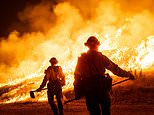It was once one of Cold War Britain's best-kept secrets.
But now, you can take a look inside the 'top secret' bunker where the government prepared for nuclear war.
For the very first time, incredible 3D scans reveal the interior of the Nottingham War Rooms.
Built between 1952 and 1953, the rooms protected one of the 11 Regional Seats of Government which would have controlled the surviving population in the event of an atomic blast.
Inside, you can still see the original dormitories, kitchens, and offices built to house up to 400 government officials.
These eerie images, made by Nottingham Trent University, even show the BBC broadcast room which would been used to communicate with survivors on the outside.
To see more of this long-hidden structure for yourself, click on 'The War Rooms' below to take the virtual tour.
During the 1950s the British government became increasingly concerned about the threat of a nuclear attack on UK cities.
A decision was made that, if Britain were to survive an attack, places must be built to protect and house whatever was left of the government.
Dr Daniel Cordle, an expert on nuclear history, told MailOnline: 'If government ceased to exist, in some sense the country would have ceased to exist.
'The idea was to preserve some continuity, but of course, the extent to which there would have been any possibility of recovery is very much open to question.'
These concerns culminated in the construction of the Nottingham War Rooms between 1952 and 1953.
This underground bunker was designed to protect about 50 government officials from a direct nuclear blast.
If this were to happen, the staff would remain hidden underground and liaise with the central government back in London.
'By the end of the decade though, after the invention of the hydrogen bomb and with many more nuclear weapons in the world, it was thought that contact with central government t might be lost for a while, or that central government might cease to exist,' says Dr Cordle.

Therefore, in 1962 the War Rooms were expanded to become one of the 11 Regional Seats of Government from which a Regional Commissioner would have had absolute power to govern the surviving population.
Controversially, these Regional Commissioners would have the power of life and death over survivors and could call for the summary execution of anyone deemed a threat.
The original War Rooms were massively expanded into a huge structure capable of housing over 400 staff.
In this interactive tour, you can see that the building consists of a larger concrete structure above ground and a series of deeper bunker rooms.
The sections above ground were only designed to protect those inside from nuclear fallout as the government hoped the site's secrecy would prevent it from being a direct target.
However, the existence of the site was revealed to the public in 1963 when the group 'Spies for Peace' published a pamphlet giving out the phone numbers of every Regional Seats of Government (RSG).
It is believed that the site was decommissioned sometime around 1967 and has lain almost untouched since that time.
This makes it a unique time capsule from Cold War Britain and a window into the government's plans for nuclear war.

Dr Cordle says: 'Most of the rooms have inventories pinned to the walls saying what, and in some cases who, would have been there, so you can build up a picture of where the different government departments would have been and how they would have functioned.'
Looking around in the virtual tour, you can see that many of the bunker's rooms are completely the same as they would have been at that time.
In the bunker, you can see both male and female dormitories filled with bunk beds and broken-down chairs.
The people sleeping in these rooms would have been given everything they needed to survive - but it would not have been a comfortable existence.
The tight corridors and cramped spaces pack in a kitchen, infirmary, and store rooms alongside large rooms from which the government would have operated.
In the kitchen, the original 1960s fridge still contains its sale guarantee while the toilets are stocked full of toilet roll with ‘Government Property’ stamped on every sheet.
On the ground floor, you will find the original pneumatic exchange room from which a huge Lamson Tube system would have shuffled messages around the bunker via compressed air.
One of the strangest parts surviving parts of the bunker is the purpose-built BBC recording studio.

This 'Emergency Broadcasting Facility' was constructed complete with sound-damping acoustic panels and an attached control room.
It is from here that the surviving members of the government would have broadcast vital information to any civilians beyond the bunker.
And, at the mechanical heart of the RSG, you can see the original generator and switch rooms which would have generated the power to provide clean air and light for the survivors.
However, even with all this preparation, it isn't clear whether the bunker could have realistically survived a nuclear attack.
Dr Cordle says: 'Nuclear war - certainly in the context of the global thermonuclear war imagined during the Cold War, and even in the case of a limited nuclear war - would have been absolutely catastrophic.
'The idea that civilised society could survive this is dubious at best.'
Interestingly, on your virtual tour, you can also spot a few modern items that hint at the bunker's more modern use.
In 1967 the site was briefly taken over by the Ministry of Agriculture, Fisheries and Food (now DEFRA) and was used as a coordinating point during the Foot and Mouth outbreak.


Amidst the original artefects you can find abandoned signs and pieces of paperwork.
One store cupboard has even been filled to the brim with boxes marked as 'urgent' veterinary samples alongside piles of blue jeans.
But after lying unused for decades the War Rooms have now been purchased by property developer Hamilton Russell who facilitated the 3D scans alongside Nottingham Trent University.
The War Rooms will now be converted into a community and commercial space including a recording studio in the former BBC emergency broadcast room.












